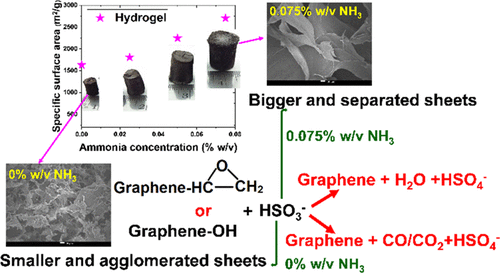当前位置:
X-MOL 学术
›
ACS Appl. Nano Mater.
›
论文详情
Our official English website, www.x-mol.net, welcomes your
feedback! (Note: you will need to create a separate account there.)
Reduction Self-Assembly of Three-Dimensional Graphene Hydrogels: Implication as Adsorbents
ACS Applied Nano Materials ( IF 5.3 ) Pub Date : 2020-10-20 , DOI: 10.1021/acsanm.0c02108 Manimegalai Ganesan 1 , Vinay A. Juvekar 1
ACS Applied Nano Materials ( IF 5.3 ) Pub Date : 2020-10-20 , DOI: 10.1021/acsanm.0c02108 Manimegalai Ganesan 1 , Vinay A. Juvekar 1
Affiliation

|
We have prepared a three-dimensional (3D) graphene hydrogel with a specific surface area that is comparable to the theoretical specific surface area of two-dimensional graphene. Graphene oxide was reduced in a glass vial using aqueous sodium bisulfite in the presence of ammonia, which regulates the rate of reduction. The kinetics of reduction was monitored by the rate of consumption of sodium bisulfite, whereas the extent of self-assembly of the reduced graphene sheets was captured through reduction in the volume of the 3D graphene with time. Dynamics of self-assembly shows two distinct regimes, namely, induction and shrinkage. During the induction period, no noticeable shrinkage in the volume occurs, although there is a significant reduction of graphene oxide. During the shrinkage period, the volume shrinks continuously with time until it reaches a constant value. The onset of shrinkage requires a critical extent of reduction of graphene oxide. We hypothesize that during the induction period, the overlapping portions of the sheets undergo lateral stacking and the reduced graphene oxide sheets undergo enlargement. With the increase in ammonia concentration, the rate of reduction is lower, the induction period is longer, and the extent of reduction at the onset of shrinkage is greater. This causes progressively greater enlargement of sheets as observed from the scanning electron micrographs of the lyophilized 3D aerogel. On further reduction, the larger sheets shrink slowly and to a lesser extent. The extent of stacking of larger sheets is also reduced significantly as seen from X-ray diffraction.
中文翻译:

三维石墨烯水凝胶的还原自组装:作为吸附剂的意义。
我们制备了具有比表面积的二维石墨烯的理论比表面积可比的三维(3D)石墨烯水凝胶。在氨存在下,使用亚硫酸氢钠水溶液在玻璃小瓶中还原氧化石墨烯,从而调节还原速率。还原的动力学通过亚硫酸氢钠的消耗速率来监测,而还原的石墨烯片的自组装程度是通过3D石墨烯的体积随时间减少而捕获的。自组装的动力学表现出两种不同的状态,即感应和收缩。在诱导期间,尽管氧化石墨烯明显减少,但体积没有出现明显的收缩。在缩水期间 音量会随着时间不断缩小,直到达到恒定值。收缩的开始要求氧化石墨烯还原的临界程度。我们假设在感应期间,薄板的重叠部分会发生横向堆叠,而还原后的氧化石墨烯薄板会变大。随着氨浓度的增加,还原速率降低,诱导时间更长,并且在收缩开始时还原程度较大。从冻干的3D气凝胶的扫描电子显微照片观察到,这会导致薄片的逐渐变大。进一步减少时,较大的纸张将缓慢收缩,收缩程度较小。如从X射线衍射所见,较大的薄片的堆叠程度也显着降低。收缩的开始要求氧化石墨烯还原的临界程度。我们假设在感应期间,薄板的重叠部分会发生横向堆叠,而还原后的氧化石墨烯薄板会变大。随着氨浓度的增加,还原速率降低,诱导时间更长,并且在收缩开始时还原程度较大。从冻干的3D气凝胶的扫描电子显微照片观察到,这会导致薄片的逐渐变大。进一步减少时,较大的纸张将缓慢收缩,收缩程度较小。如从X射线衍射所见,较大的薄片的堆叠程度也显着降低。收缩的开始要求氧化石墨烯还原的临界程度。我们假设在感应期间,薄板的重叠部分会发生横向堆叠,而还原后的氧化石墨烯薄板会变大。随着氨浓度的增加,还原速率降低,诱导时间更长,并且在收缩开始时还原程度较大。从冻干的3D气凝胶的扫描电子显微照片观察到,这会导致薄片的逐渐变大。进一步减少时,较大的纸张将缓慢收缩,收缩程度较小。如从X射线衍射所见,较大的薄片的堆叠程度也显着降低。片材的重叠部分横向堆叠,并且还原的氧化石墨烯片材变大。随着氨浓度的增加,还原速率降低,诱导时间更长,并且在收缩开始时还原程度较大。从冻干的3D气凝胶的扫描电子显微照片观察到,这会导致薄片的逐渐变大。进一步减少时,较大的纸张将缓慢收缩,收缩程度较小。如从X射线衍射所见,较大的薄片的堆叠程度也显着降低。片材的重叠部分横向堆叠,并且还原的氧化石墨烯片材变大。随着氨浓度的增加,还原速率降低,诱导时间更长,并且在收缩开始时还原程度较大。从冻干的3D气凝胶的扫描电子显微照片观察到,这会导致薄片的逐渐变大。进一步减少时,较大的纸张将缓慢收缩,收缩程度较小。如从X射线衍射所见,较大的薄片的堆叠程度也显着降低。并且收缩开始时的减少程度更大。从冻干的3D气凝胶的扫描电子显微照片观察到,这会导致薄片的逐渐变大。进一步减少时,较大的纸张将缓慢收缩,收缩程度较小。如从X射线衍射所见,较大的薄片的堆叠程度也显着降低。并且收缩开始时的减少程度更大。从冻干的3D气凝胶的扫描电子显微照片观察到,这会导致薄片的逐渐变大。进一步减少时,较大的纸张将缓慢收缩,收缩程度较小。如从X射线衍射所见,较大的薄片的堆叠程度也显着降低。
更新日期:2020-11-25
中文翻译:

三维石墨烯水凝胶的还原自组装:作为吸附剂的意义。
我们制备了具有比表面积的二维石墨烯的理论比表面积可比的三维(3D)石墨烯水凝胶。在氨存在下,使用亚硫酸氢钠水溶液在玻璃小瓶中还原氧化石墨烯,从而调节还原速率。还原的动力学通过亚硫酸氢钠的消耗速率来监测,而还原的石墨烯片的自组装程度是通过3D石墨烯的体积随时间减少而捕获的。自组装的动力学表现出两种不同的状态,即感应和收缩。在诱导期间,尽管氧化石墨烯明显减少,但体积没有出现明显的收缩。在缩水期间 音量会随着时间不断缩小,直到达到恒定值。收缩的开始要求氧化石墨烯还原的临界程度。我们假设在感应期间,薄板的重叠部分会发生横向堆叠,而还原后的氧化石墨烯薄板会变大。随着氨浓度的增加,还原速率降低,诱导时间更长,并且在收缩开始时还原程度较大。从冻干的3D气凝胶的扫描电子显微照片观察到,这会导致薄片的逐渐变大。进一步减少时,较大的纸张将缓慢收缩,收缩程度较小。如从X射线衍射所见,较大的薄片的堆叠程度也显着降低。收缩的开始要求氧化石墨烯还原的临界程度。我们假设在感应期间,薄板的重叠部分会发生横向堆叠,而还原后的氧化石墨烯薄板会变大。随着氨浓度的增加,还原速率降低,诱导时间更长,并且在收缩开始时还原程度较大。从冻干的3D气凝胶的扫描电子显微照片观察到,这会导致薄片的逐渐变大。进一步减少时,较大的纸张将缓慢收缩,收缩程度较小。如从X射线衍射所见,较大的薄片的堆叠程度也显着降低。收缩的开始要求氧化石墨烯还原的临界程度。我们假设在感应期间,薄板的重叠部分会发生横向堆叠,而还原后的氧化石墨烯薄板会变大。随着氨浓度的增加,还原速率降低,诱导时间更长,并且在收缩开始时还原程度较大。从冻干的3D气凝胶的扫描电子显微照片观察到,这会导致薄片的逐渐变大。进一步减少时,较大的纸张将缓慢收缩,收缩程度较小。如从X射线衍射所见,较大的薄片的堆叠程度也显着降低。片材的重叠部分横向堆叠,并且还原的氧化石墨烯片材变大。随着氨浓度的增加,还原速率降低,诱导时间更长,并且在收缩开始时还原程度较大。从冻干的3D气凝胶的扫描电子显微照片观察到,这会导致薄片的逐渐变大。进一步减少时,较大的纸张将缓慢收缩,收缩程度较小。如从X射线衍射所见,较大的薄片的堆叠程度也显着降低。片材的重叠部分横向堆叠,并且还原的氧化石墨烯片材变大。随着氨浓度的增加,还原速率降低,诱导时间更长,并且在收缩开始时还原程度较大。从冻干的3D气凝胶的扫描电子显微照片观察到,这会导致薄片的逐渐变大。进一步减少时,较大的纸张将缓慢收缩,收缩程度较小。如从X射线衍射所见,较大的薄片的堆叠程度也显着降低。并且收缩开始时的减少程度更大。从冻干的3D气凝胶的扫描电子显微照片观察到,这会导致薄片的逐渐变大。进一步减少时,较大的纸张将缓慢收缩,收缩程度较小。如从X射线衍射所见,较大的薄片的堆叠程度也显着降低。并且收缩开始时的减少程度更大。从冻干的3D气凝胶的扫描电子显微照片观察到,这会导致薄片的逐渐变大。进一步减少时,较大的纸张将缓慢收缩,收缩程度较小。如从X射线衍射所见,较大的薄片的堆叠程度也显着降低。











































 京公网安备 11010802027423号
京公网安备 11010802027423号